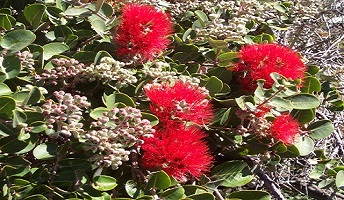Last updated: September 21, 2022
Lesson Plan
‘Ōhiʻa Lehua: An Amazing Adaptor

- Grade Level:
- Upper Elementary: Third Grade through Fifth Grade
- Subject:
- Science
- Lesson Duration:
- 60 Minutes
- State Standards:
- Hawai‘i Content and Performance Standards III:
SC.3.3.1, SC.3.4.1, SC.3.5.1 - Additional Standards:
- Next Generation Science Standards:
3-LS3-2, 3-LS4-3 - Thinking Skills:
- Remembering: Recalling or recognizing information ideas, and principles. Understanding: Understand the main idea of material heard, viewed, or read. Interpret or summarize the ideas in own words. Analyzing: Break down a concept or idea into parts and show the relationships among the parts. Evaluating: Make informed judgements about the value of ideas or materials. Use standards and criteria to support opinions and views.
Essential Question
How do plants and animals use adaptations to survive in an environment?
What kind of impacts can happen to a species and influence its adaptations?
Objective
At the end of this lesson, the students will be able to:
1. Describe how plants and animals use adaptations to survive in particular environment.
2. Explain how impacts on a habitat can influence the adaptations of a species.
Background
Many ecosystems exist within Haleakalā National Park. Haleakalā, rises from the sea to a harsh dry 10,023 foot summit. It is exposed to both the windward moist trade winds and leeward drying air. Wind, rain, temperature, and altitude all play a role in shaping each environment. The varied elevation, along with different wind and rainfall, has created a variety of natural ecosystems.
Plants such as the ‘ōhiʻa lehua use adaptations to survive in each different environment. The exceptional adaptations of the ‘ōhiʻa lehua help it to survive in almost every environment from the ocean to the summit.
Preparation
Materials Needed:
‘Ōhiʻa lehua Fact Sheet (2 sided, included)
Materials
‘Ōhiʻa Lehua Fact Sheet with two images
Download ‘Ōhiʻa Lehua Fact Sheet
Lesson Hook/Preview
Explore with students the different ecosystems found on Maui and learn how one plant can survive in most of those ecosystems.
Procedure
Step 1: Review different Hawaiian ecosystems
Explore with students the different ecosystems found on Maui. How many of you have ever been to the summit or the highest point of Haleakalā before? If you drive from the beach to the summit, you go through as many different ecosystems as if you were to drive from Mexico to Alaska! Spend some time asking students what they experience in each area.
Step 2: Adaptations
- Review with students how various adaptations are needed for a species to survive within a specific ecosystem.
- Pass out the 2-sided ʻŌhiʻa lehua Fact Sheet and read together the facts about ʻōhiʻa lehua.
- The ʻōhiʻa lehua has the amazing ability to survive in very different environments from deserts to rainforests.
- Ask students to think of other plants or animals that could survive in almost any environment.
- The ʻōhiʻa lehua is the most common native tree in Hawaiʻi and is endemic which means it is a native plant that has adapted to this specific environment over time and is found nowhere else in the world. The ʻōhiʻa lehua is a highly adaptable tree and has many forms. Scientists know of at least 8 different varieties of this tree.
Step 3: Intro to Latin names
Every species (bird, plant etc.) has a Latin name. The Latin name usually gives a big hint to what the species is like. In Hawai‘i, we call it by its Hawaiian name, ʻōhiʻa lehua. In other parts of the world, people use its Latin name. Metrosideros polymorpha “poly” means “many” and “morpha” means “forms”.
Step 4: Journal Activity
- Where could the ʻōhiʻa lehua survive?
- What adaptations has the ʻōhiʻa lehua made to survive?
- How do you survive (clothes etc.) when you visit different environments?
- What would happen if the ʻōhiʻa lehua went extinct?
Vocabulary
Ecosystem: A complex set of relationships among the living resources, habitats, and residents of an area.
Endemic: Native species that have adapted to a specific region over time and are found nowhere else.
Survival: Meets the needs of food, water, shelter and space.
